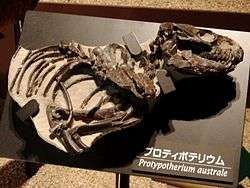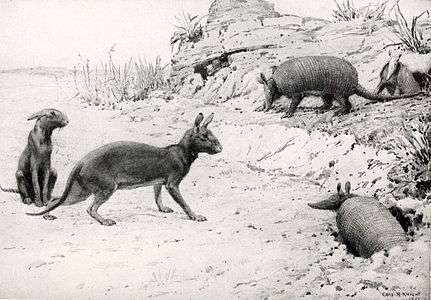Protypotherium
| Protypotherium | |
|---|---|
 | |
| Fossil of P. australe. Exhibit in the National Museum of Nature and Science, Tokyo, Japan | |
| Scientific classification | |
| Kingdom: | Animalia |
| Phylum: | Chordata |
| Class: | Mammalia |
| Order: | †Notoungulata |
| Suborder: | †Typotheria |
| Family: | †Interatheriidae |
| Genus: | †Protypotherium Ameghino, 1882 |
Protypotherium is an extinct genus of notoungulate mammals native to South America during the Miocene epoch. A number of closely related animals date back further, to the Paleocene. Fossils of Protypotherium have been found in the Deseadan Fray Bentos Formation of Uruguay, Muyu Huasi Formation of Bolivia, Cura-Mallín and Río Frías Formations of Chile and Santa Cruz, Salicas, Ituzaingó, Cerro Bandera, Chichinales, Sarmiento and Collón Cura Formations of Argentina.[1]
Description


Protypotherium was slightly larger than a rabbit, measuring about 40 centimetres (1.3 ft) in length. The body and legs as well as the tail of this animal were relatively long, while its neck was short. It probably resembled a rodent, possessing slender limbs with clawed feet. Its rat-like skull contained a set of 44 unspecialized teeth.[2]
From the shape of its claws, Protypotherium would have been adept at digging and likely took over the burrows of other animals.
References
- ↑ Protypotherium at Fossilworks.org
- ↑ Palmer, D., ed. (1999). The Marshall Illustrated Encyclopedia of Dinosaurs and Prehistoric Animals. London: Marshall Editions. p. 251. ISBN 1-84028-152-9.